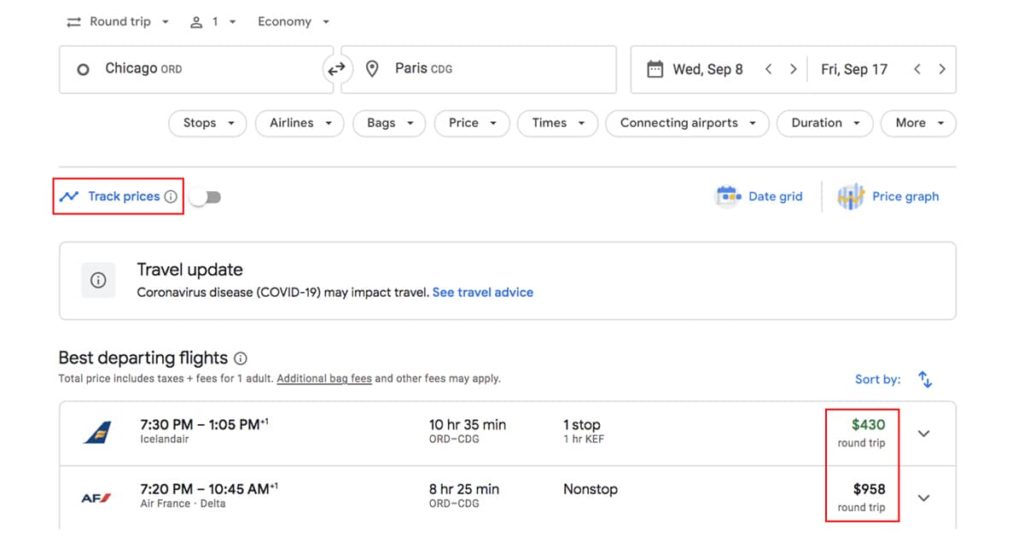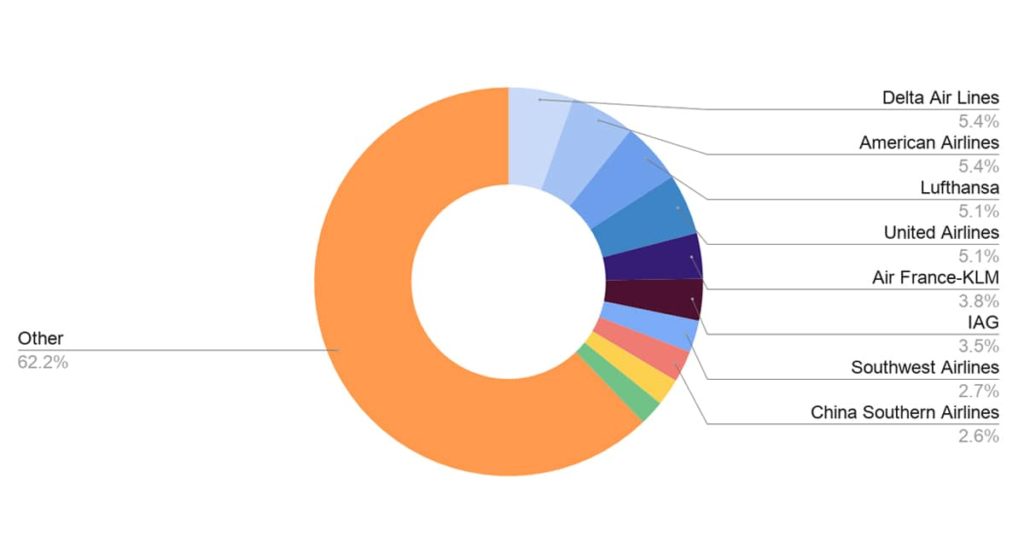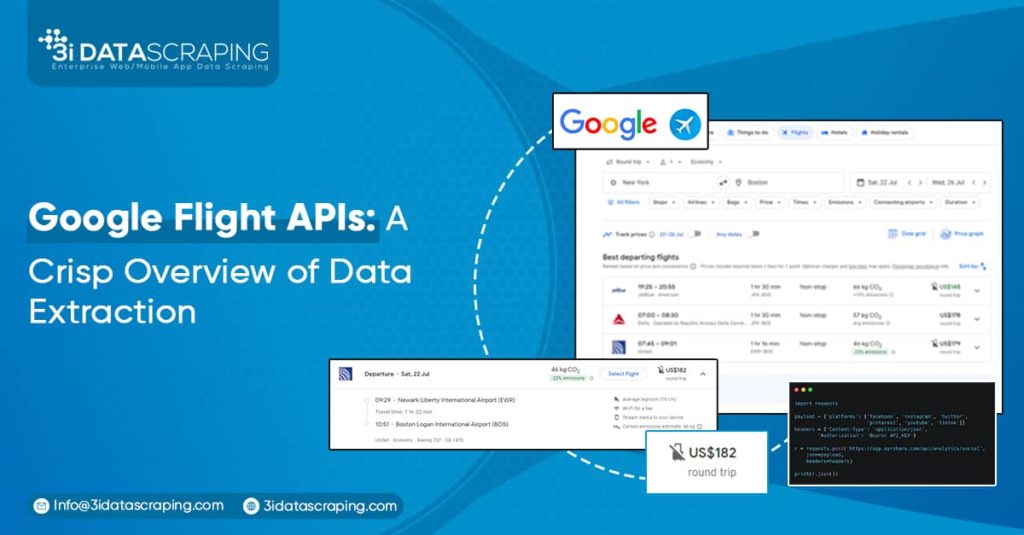Google Flight APIs: A Crisp Overview of Data Extraction
- July 13, 2023
Our achievements in the field of business digital transformation.









Introduction
In simple terms, Google APIs are a set of application programming interfaces (APIs) that Google made to make it easier to talk to Google Services. APIs follow certain rules and procedures so that requests and answers can be sent and received clearly. API is very important in the world we live in now. Access to data and computing tools significantly boosts a developer’s efficiency.
So, using an API is much easier than building each program, method, or data set. Google has APIs that can be used in many different areas and industries, like machine learning (ML), data science, travel and leisure, etc. In this blog, we’ll be talking about the second one.
Understanding Google Flight API

As we’ve already said, the Google API allows programs to talk to the Google Cloud Platform Services. APIs are a big part of Google Cloud Platform, and they let you use the power of everything, from computing to networking to storage to data based on machine learning, in your apps in an efficient way.
From the idea of Google API comes Google Flight API, a phenomenon that gives developers access to aggregated and gathered airline data like flight times, availability, price, and more. About nine years ago, Google revealed that it was buying ITA Software Inc., which it used to build its API. But in 2018, Google stopped letting the public use the API. The QPX business product is the only way to use the API.
Importance of real-time flight data extraction for the travel industry

Data extraction helps the travel business in a lot of ways. What do they mean? Let us find out!
- Revenue Management
RM is the process of using data and analytics to figure out how to sell a product to people who need it, at a fair price, at the best time, and through the best route. The idea behind the concept is that people have different ideas about how much something is worth, so how much they are willing to pay for an item depends on who they are and when they buy it. In the travel and tourism industry, revenue management can be used to define destinations and change flight prices for certain markets, find efficient distribution methods, manage airline seats, keep the airline competitive and customer-focused, and so on.
- Air Safety and Airplane Upkeep
The second way data extraction is crucial to the travel business is through safety and maintenance in the air. Contrary to what most people think, the airline is the one who pays for the high costs of delays and cancellations. This includes repair costs and paying people who are stuck at airports.
A new report from PWC says that unplanned maintenance is responsible for about 30 percent of all flight delays. So, forecast analytics can be used to help with technical support for fleets. Also, airlines can use data-based prediction analysis to improve how they run and keep track of the health of their planes.
- Crew Management
Managing a crew in the flight or travel business is a hard, time-consuming, and detailed job. Assigning crews to the thousands of trips that happen every day is a tremendous job. During the process, specialists consider things like the flight route, the licenses and qualifications of each crew member, the type of aircraft, work rules, days off, etc., to ensure that the plans of pilots and passengers don’t clash.
The strategic use of big data can make the job of people handling or scheduling crews easier. The massive amount of data that airlines create, such as maintenance and passenger data, data from onboard sensors, etc., can be used smartly to make assigning crew to different aircraft easier. Using reports and observations based on data, schedules can make the best plan for working hours, crew qualifications, costs, use of aircraft, and more.
- Optimizing Fuel Efficiency
Lastly, efficient fuel use is another big plus of data extraction in the flight industry. It’s too bad that worldwide aviation is responsible for almost 2% of artificial carbon dioxide emissions. So, airlines are responsible for using fuel as efficiently as possible. The best way to use aviation fuel is also good for the environment and saves money on general airline operations.
Data and AI can be used together to determine the best path based on distance, altitude, type and weight of aircraft, weather, etc. Systems can predict how much fuel a flight needs based on what they learn from the data.
Data Extraction has more benefits than the four listed above in the travel and tourism business. These include feedback analysis, automated messaging, airport self-service, and more.
Benefits of using Google Flight API for data extraction
Some of the Benefits of Getting info from Google Flight API are:
- With Google Flight API integration, travelers can look for trips and book them.
- It also ensures the visitor can get to where they want to go.
- Integration with Google Flights includes all important information, such as discounts, offers, prices, deals, availability, etc.
- Integration of the Google Flight API helps cut down on running costs.
- With Google Flight API, airline service companies from all over the world can connect. So people can compare the prices of different airlines in real time.
- Integration with the Google Flight API is easy and provides proof right away.
- All travel and tourist companies could increase their brand value if they took data from Google Flight API.
- Google Flight API works with all kinds of currencies from all over the world.
Use Cases for Extracted Flight Data
The different ways that flying data can be used are:
- Price Monitoring
In the flight business, keeping up with the competition by keeping an eye on prices is important. The process lets airlines measure the demand and supply of the market and improve their demand management based on how the market is doing at the moment. The process can be made easier with the right tool for extracting info.
- Analyzing Market Share and Trends
You can also use Flight Data Extraction and scraping to look at how the airline market is doing. This means that airlines can.
- Find out how well their competitors are doing by looking at how much of the total air travel market each of them has.
- Find places in the airline industry where investment is growing.
- Find out who the top competitors are and how they set their goods and services apart.
Boost the growth plan to raise the company’s profile and how the public sees it.
Future Possibilities
The future looks bright and big for data mining and Google Flight APIs. Real-time info from Google has much potential to help airlines improve their performance and focus on their customers. It has essential benefits like saving money and making things more personal.
Conclusion
In a nutshell, the Google Flight APIs provide a streamlined and comprehensive approach to data extraction, offering users a clear and concise overview of crucial flight information. With its efficient features, developers can seamlessly integrate this API into their applications to empower users with real-time flight data, Pricing Trends, and booking options. By harnessing the power of Google Flight APIs, businesses can create enhanced travel experiences, optimize their operations, and offer valuable insights to travelers. With its crisp and user-friendly interface, the Google Flight APIs are a valuable tool for anyone seeking to enrich the travel industry with accurate and up-to-date flight data.














What Will We Do Next?
- Our representative will contact you within 24 hours.
- We will collect all the necessary requirements from you.
- The team of analysts and developers will prepare estimation.
- We keep confidentiality with all our clients by signing NDA.





